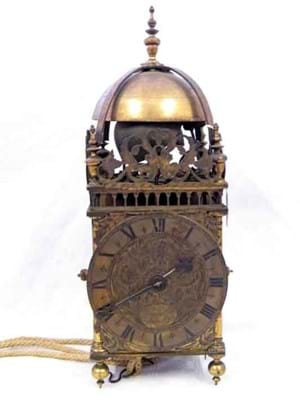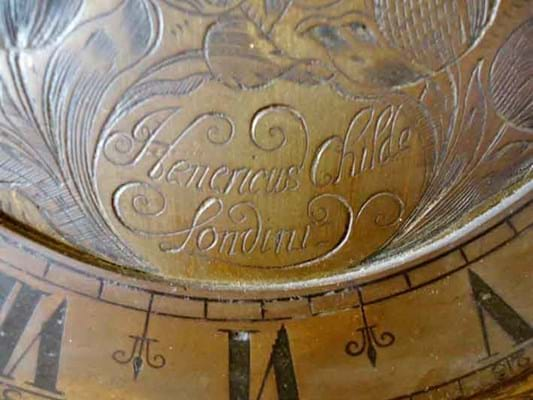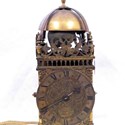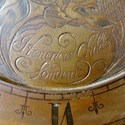A sophisticated timekeeper sharing design elements pioneered by Peter Closon of Holborn Bridge and Ahasuerus Fromanteel, it features a horizontal crown wheel and verge escapement driven by three chains, three bells striking on the quarter hours and is equipped with a minute hand.
Outwardly, too, it shares many characteristics with early clocks from the so-called Third Period of lantern clock-making, including a narrow silvered chapter ring and a brass dial plate finely engraved with the name Henricus Childe, Londini and the tulip blooms associated with the Restoration and the return of the court from exile in Holland.
Henry Child was made a member of the Clockmakers' Company in 1642 and is thought to have died during the Great Plague of 1665.
As Master of the Clockmakers' Company he presided over a meeting in July 1665 held at The George, Ivy Lane, but by the following meeting it was recorded: "Mrs Childe, the widow of our late deceased Master, appeared upon the summons given her. And it was determined and ordered that [the warden] shall receive from her the Companyes chest and bagg of bookes and keyes in her custody, and upon receipt of them shall deliver to her the bond which he and his suretyes gave the Company."
This Beccles clock is described in Britten's Old Clocks And Watches And Their Makers as a "three-train 'ting-tang' lantern clock" belonging to the London collector R. Eden Dickson.
It was evidently sold by auction shortly after the Second World War and was bought by Durrants' clients in Dorchester on May 27, 1946, for £57. Throughout its life in a five-storey, end-of-terrace house in Northgate, Beccles, it was left in the same unrestored condition in which it was purchased.
Estimated at £1500-2000 for the sale on March 30, it prompted over 30 condition report requests and multiple bidders before selling at £26,700 (plus 12.5 per cent buyer's premium) to a Swindon-based clock dealer said to be bidding for his private collection.








